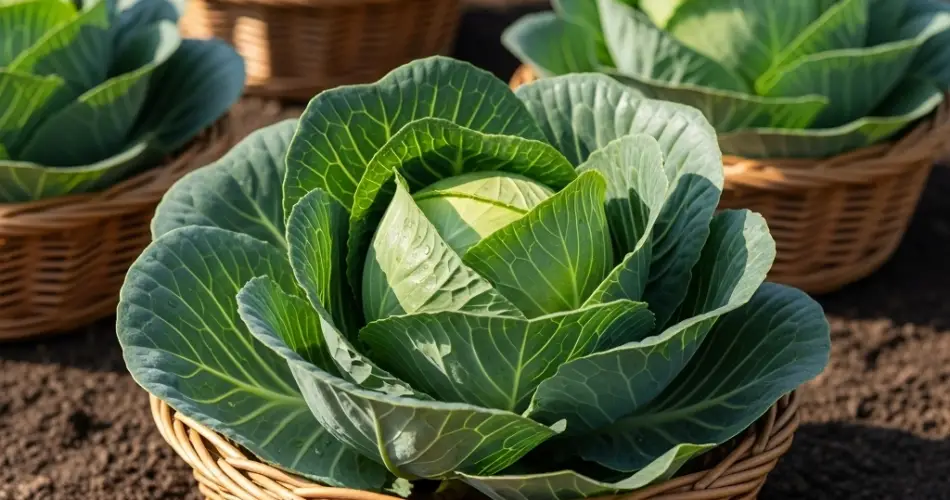Cabbage is a nutritious and versatile vegetable that thrives even in limited spaces, making it an excellent choice for urban gardeners. Hanging pots offer a convenient and productive way to grow cabbage on balconies, patios, and terraces without the need for traditional garden beds. With proper care, these container-grown cabbages can provide crisp, flavorful heads, delivering fresh nutrition right to your kitchen while maximizing small-space gardening potential.
Why Hanging Pots Work for Cabbage
Hanging pots offer several advantages for growing cabbage. Elevating plants off the ground improves air circulation, which helps prevent fungal diseases and reduces the risk of pests. The portability of hanging pots allows gardeners to move plants for optimal sunlight or protection from harsh weather conditions. Additionally, hanging containers provide excellent drainage, preventing waterlogging—a common issue that can affect root health in traditional garden beds.
Selecting the Right Hanging Pot
Choosing the right pot is critical for successful cabbage cultivation. Cabbage plants require deep, nutrient-rich soil to develop firm, healthy heads. A hanging pot with a depth of at least 12 inches is ideal, while the diameter should be wide enough to accommodate one or two plants comfortably. Ensure the pot has adequate drainage holes to allow excess water to escape. Woven or fabric pots are particularly suitable, as they provide breathability, promote healthy root development, and are lightweight enough for hanging securely.
Preparing the Soil
Cabbage thrives in fertile, well-draining soil that is rich in organic matter. A high-quality potting mix blended with compost or well-rotted manure provides essential nutrients while keeping the soil light and loose. Avoid compacted garden soil, which can restrict root growth and reduce head formation. Cabbage prefers a slightly acidic to neutral soil with a pH between 6.0 and 7.0. Adding a slow-release organic fertilizer at planting supports initial growth, while supplemental feeding with liquid fertilizer every two to three weeks promotes strong leaves and robust heads.
Choosing the Right Cabbage Varieties
Not all cabbage varieties are suitable for hanging pots. Compact, dwarf, or early-maturing varieties are ideal for container gardening, as they develop smaller, dense heads without overwhelming the pot. Leaf cabbage varieties can also be grown, providing a continuous supply of tender leaves for salads and cooking. Selecting varieties suited for containers ensures better growth, higher yields, and easier maintenance in small spaces.
Planting Cabbage in Hanging Pots
Planting cabbage in hanging pots requires attention to spacing and soil depth:
-
Fill the pot with prepared soil, leaving about 2 inches from the top.
-
Plant seedlings at an appropriate spacing, usually 12–18 inches apart for dwarf types.
-
Firm the soil gently around the base and water thoroughly.
-
Apply mulch around the plants to retain moisture and regulate soil temperature.
Proper planting and spacing ensure that cabbage heads form fully and that plants do not compete for nutrients.
Caring for Hanging-Pot Cabbage
Cabbage in hanging pots requires consistent care. Keep the soil evenly moist, as inconsistent watering can lead to split heads or bitter flavor. Hanging pots tend to dry out faster than ground-level beds, so check moisture levels frequently, especially during hot or dry weather. Cabbage grows best in full sun but tolerates partial shade in warmer climates.
Prune damaged or yellowed leaves regularly to maintain airflow and reduce the risk of disease. Fertilize every two to three weeks with a balanced liquid fertilizer to support healthy growth and head formation. Avoid excessive nitrogen, which can encourage leafy growth at the expense of dense, crisp heads.
Pest and Disease Management
Although hanging pots reduce many soil-borne issues, cabbage can still be susceptible to pests like aphids, cabbage worms, and slugs. Inspect plants regularly, remove affected leaves, and use organic solutions such as neem oil or insecticidal soap when necessary. Maintaining proper spacing, pruning, and watering practices helps minimize pest and disease problems, ensuring healthy, productive cabbage plants.
Harvesting Cabbage
Cabbage is ready to harvest when heads are firm, dense, and well-formed. Use a sharp knife to cut the head at the base, leaving outer leaves intact if desired. For leaf cabbage varieties, pick outer leaves regularly to encourage continuous growth. Frequent harvesting keeps plants healthy and ensures a steady supply of fresh, nutritious cabbage throughout the growing season.
Benefits of Hanging-Pot Cabbage Gardening
Growing cabbage in hanging pots maximizes vertical space, making it ideal for urban environments. It allows gardeners to control soil quality, watering, and sunlight, resulting in healthier plants and better-tasting produce. Hanging pots also enhance the visual appeal of balconies, patios, or terraces, while providing easy access to fresh, homegrown vegetables. Container-grown cabbage offers convenience, nutrition, and the satisfaction of harvesting your own food, even in small spaces.
Conclusion
Hanging pots make growing cabbage in urban gardens practical, efficient, and rewarding. By choosing the right container, preparing nutrient-rich soil, selecting suitable varieties, and providing consistent care, gardeners can enjoy crisp, healthy cabbage throughout the season. This method transforms small outdoor spaces into productive, vibrant gardens, delivering fresh nutrition and the joy of homegrown vegetables right at your fingertips.



